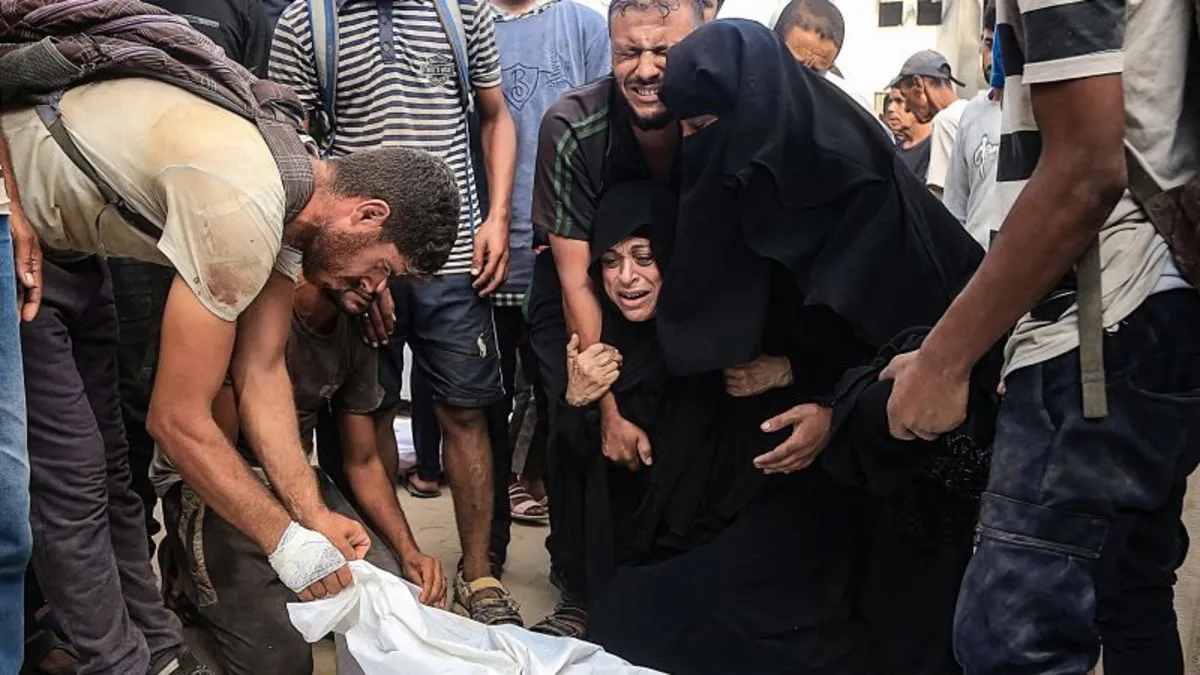
Recent reports indicate that Israeli troops opened fire on civilians in Gaza who were desperately seeking food aid, resulting in the tragic deaths of at least 32 individuals, according to the Palestinian health ministry and eyewitnesses. The health ministry has confirmed that the bodies were transported to the Nasser Medical Complex, where dozens of others were treated for injuries sustained during the incident. Disturbing footage from CNN captured the somber scene at the hospital, showing long lines of bodies as families mourned their losses. One father, holding his deceased son, poignantly remarked, “He just wanted to eat, what could I do?”
The exact location of the shooting remains unclear. Eyewitness Hisham Dargam reported that the incident occurred approximately 4 kilometers (2.5 miles) from an aid distribution point operated by the Gaza Humanitarian Foundation (GHF), a controversial organization backed by both Israel and the United States. Dargam described the scene, stating, “Gunfire erupted from soldiers and tanks, as if they were in a battle with us.” In response, the Israeli military claimed that troops had identified suspects approaching them during operational activities in the Rafah area, about one kilometer from the aid site, specifically during nighttime when the area was less active.
The Israel Defense Forces (IDF) stated that troops had fired warning shots and are currently investigating the reports of casualties. Meanwhile, the Gaza Humanitarian Foundation has denied any incidents occurring “at or near” their distribution sites on the day of the shooting. They emphasized that the reported IDF activity leading to fatalities transpired hours before their sites opened for aid distribution, asserting that most casualties occurred several kilometers away from the nearest GHF location. The GHF also mentioned that they had consistently warned those seeking aid against traveling to their sites during the nighttime hours.
Despite these warnings, many Gazans have conveyed to CNN that they are compelled to travel to distribution points several hours prior to their opening to secure a chance at receiving aid. Food scarcity in the Gaza Strip has reached critical levels, with numerous UN assessments indicating that people are starving. The lack of transportation means that many individuals are forced to walk long distances to reach GHF centers, further exacerbating their plight.
Dr. Travis Melin, a physician at Nasser Hospital, reported that many of the victims from Saturday’s incident suffered “severe” gunshot wounds to their torsos and heads. Since the GHF commenced its operations in Gaza in May, hundreds of people have lost their lives while attempting to access aid. According to the UN High Commissioner for Human Rights, nearly 800 individuals were killed in this manner between late May and July 7, with 615 fatalities occurring near GHF distribution sites. Dr. Melin lamented the dire situation, stating, “Food here is a luxury of the privileged,” highlighting that those who can afford food are exceptionally fortunate.
The director of communications for UNRWA, the United Nations agency that provides relief to Palestinian refugees, criticized the current aid distribution system in Gaza, describing it as a “death trap for starving Palestinians.” The director called for UNRWA to be reinstated as the lead organization in managing aid efforts, emphasizing the urgent need for reform.
In parallel to these tragic events, US President Donald Trump expressed optimism regarding ongoing ceasefire negotiations between Israel and Hamas. “In Gaza, we got most of the hostages back,” he stated on Friday evening, adding that efforts to finalize another ten hostage releases are underway. While Trump’s comments reflect a positive outlook, both sides in the conflict are exchanging accusations over the stalling of ceasefire talks.
Hamas has warned that it “cannot guarantee” future agreement to pauses in the conflict unless Israel commits to working toward a complete cessation of hostilities. Historically, Israel has been reluctant to agree to permanent ceasefire terms, insisting on continuing military action in Gaza until Hamas is dismantled. Hamas spokesperson Abu Obaida claimed that the Israeli government, led by Prime Minister Benjamin Netanyahu, shows little genuine concern for the captives’ welfare, suggesting that their focus is primarily on soldiers.
According to an Israeli official, one major hurdle in the negotiations is Hamas’ refusal to discuss the so-called “release key,” which pertains to the criteria used for identifying individuals eligible for release in a potential swap. The Israeli source insisted that while Israel remains flexible in negotiations, it is Hamas that is accused of “foot-dragging” in the talks.